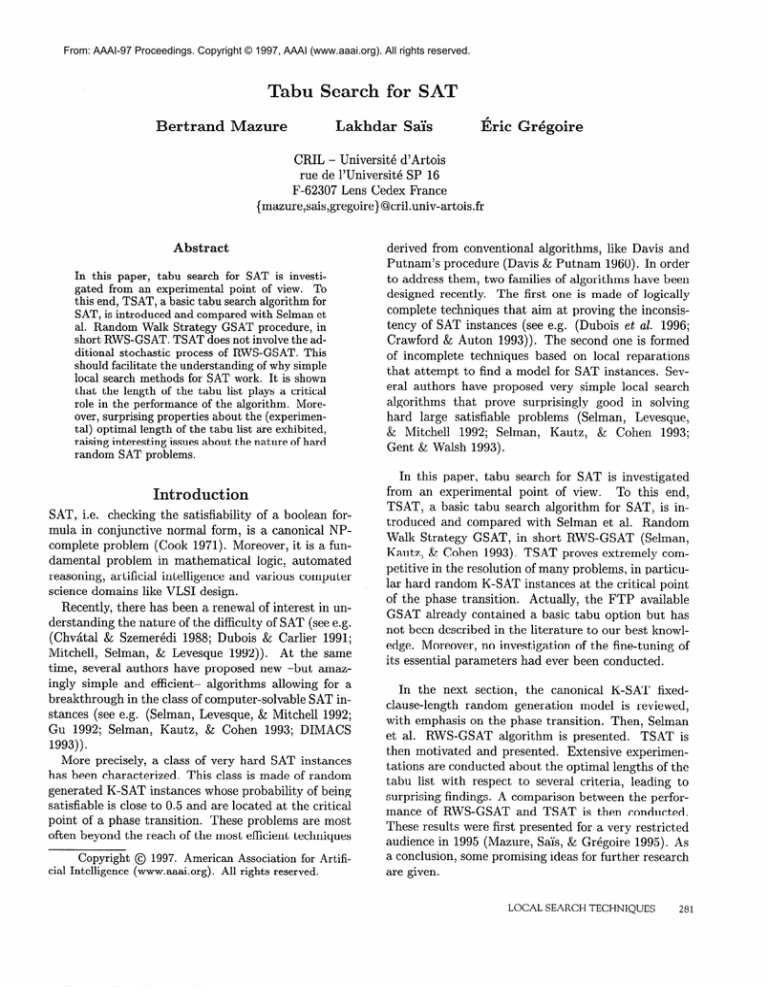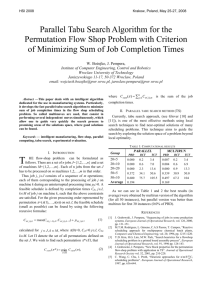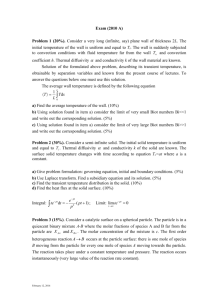
From: AAAI-97 Proceedings. Copyright © 1997, AAAI (www.aaai.org). All rights reserved.
Tabu Search for SAT
Bertrand Mamre
Lakhdar Sails
lhic Gr6goire
CRIL - Universite d’Artois
rue de l’universite SP 16
F-62307 Lens Cedex France
{mazure,sais,gregoire}@cril.univ-artois.fr
Abstract
In this paper, tabu search for SAT is investigated from an experimental point of view. To
this end, TSAT, a basic tabu search algorithm for
SAT, is introduced and compared with Selman et
al. Random Walk Strategy GSAT procedure, in
short RWS-GSAT. TSAT does not involve the additional stochastic process of RWS-GSAT. This
should facilitate the understanding of why simple
local search methods for SAT work. It is shown
that the length of the tabu list plays a critical
role in the performance of the algorithm. Moreover, surprising properties about the (experimental) optimal length of the tabu list are exhibited,
raising interesting issues about the nature of hard
random SAT problems.
Introduction
SAT, i.e. checking the satisfiability of a boolean formula in conjunctive normal form, is a canonical NPcomplete problem (Cook 1971). Moreover, it is a fundamental problem in mathematical logic, automated
reasoning, artificial intelligence and various computer
science domains like VLSI design.
Recently, there has been a renewal of interest in understanding the nature of the difficulty of SAT (see e.g.
(Chvatal & Szemeredi 1988; Dubois & Carlier 1991;
Mitchell, Selman, & Levesque 1992)).
At the same
time, several authors have proposed new -but amazingly simple and efficient- algorithms allowing for a
breakthrough in the class of computer-solvable SAT instances (see e.g. (Selman, Levesque, & Mitchell 1992;
Gu 1992; Selman, Kautz, & Cohen 1993; DIMACS
1993)).
More precisely, a class of very hard SAT instances
has been characterized. This class is made of random
generated K-SAT instances whose probability of being
satisfiable is close to 0.5 and are located at the critical
point of a phase transition. These problems are most
often beyond the reach of the most efficient techniques
Copyright @ 1997. American Association for Artificial Intelligence (www.aaai.org). All rights reserved.
derived from conventional algorithms, like Davis and
Putnam’s procedure (Davis & Putnam 1960). In order
to address them, two families of algorithms have been
designed recently. The first one is made of logically
complete techniques that aim at proving the inconsistency of SAT instances (see e.g. (Dubois et al. 1996;
Crawford & Auton 1993)). The second one is formed
of incomplete techniques based on local reparations
that attempt to find a model for SAT instances. Several authors have proposed very simple local search
algorithms that prove surprisingly good in solving
hard large satisfiable problems (Selman, Levesque,
& Mitchell 1992; Selman, Kautz, & Cohen 1993;
Gent & Walsh 1993).
In this paper, tabu search for SAT is investigated
from an experimental point of view. To this end,
TSAT, a basic tabu search algorithm for SAT, is introduced and compared with Selman et al. Random
Walk Strategy GSAT, in short RWS-GSAT (Selman,
Kautz, & Cohen 1993). TSAT proves extremely competitive in the resolution of many problems, in particular hard random K-SAT instances at the critical point
of the phase transition.
Actually, the FTP available
GSAT already contained a basic tabu option but has
not been described in the literature to our best knowledge. Moreover, no investigation of the fine-tuning of
its essential parameters had ever been conducted.
In the next section, the canonical K-SAT fixedclause-length random generation model is reviewed,
with emphasis on the phase transition. Then, Selman
et al. RWS-GSAT algorithm is presented. TSAT is
then motivated and presented. Extensive experimentations are conducted about the optimal lengths of the
tabu list with respect to several criteria, leading to
surprising findings. A comparison between the performance of RWS-GSAT and TSAT is then conducted.
These results were first presented for a very restricted
audience in 1995 (Mazure, Sais, & Gregoire 1995). As
a conclusion, some promising ideas for further research
are given.
LOCAL SEARCH TECHNIQUES
281
.,3
I
n=25 n=60 -+----
k
I’
80
60
8
6
C/l-l
Figure 1: phase transition phenomena
Hard random SAT instances
SAT consists in checking the satisfiability of a boolean
formula in conjunctive normal form (CNF). Let us recall here that any propositional formula can be translated into a CNF that is equivalent for SAT, thanks
to a linear time algorithm (see e.g. (Siegel 1987)). A
CNF formula is a set (interpreted as a conjunction) of
clauses, where a clause is a disjunction of literals. A
literal is a positive or a negated propositional variable.
An interpretation of a boolean formula is an assignment of truth values to its variables. A model of a
formula is an interpretation that satisfies the formula.
Although SAT is NP-complete, theoretical and experimental results show good average-case performance for several classes of SAT instances (see e.g.
(Franc0 & Paul1 1983)).
However, hard random instances of SAT have been
observed at a phase transition.
Let us illustrate
this phenomenon in the usual K-SAT fixed-clauselength model (see e.g. (Chvatal & Szemeredi 1988;
Cheeseman, Kanefsky, & Taylor 1991; Crawford & Auton 1993; Dubois & Carlier 1991; Mitchell, Selman, &
Levesque 1992))) a random generation model where the
number of literals per clause is a given value K and the
sign of each literal is also randomly generated (with a
0.5 probability).
In Figures 1 and 2, we see the phase transition observed by many authors. The probability of satisfiability decreases abruptly from 1 to converge towards 0
in a phase transition as the c/n ratio increases (where
c represents the number of clauses and n the number
of variables). The location of the phase transition depends on the length of clauses and on the number of
variables. In Figure 1, we see how the curves move to
the right as this length increases. In Figure 2, we see
282
CONSTRAINT SATISFACTION & SEARCH
0
0
2
4
c/n
6
8
10
Figure 2: 3-SAT
how the curves straighten when the number of variables increases. It has been shown experimentally that
instances at these phase transitions where the probability of being satisfiable is 0.5 are really hard problems.
Actually, it has been proved that these problems are
exponential for resolution (Chvatal & Szemeredi 1988).
Random Walk Strategy GSAT
Let us now briefly review Selman et al. GSAT algorithm (Selman, Levesque, & Mitchell 1992). This algorithm performs a greedy local search for a satisfying
assignment of a set of propositional clauses. The algorithm starts with a randomly generated truth assignment. It then changes (“flips”) the assignment of the
variable that leads to the largest increase in the total
number of satisfied clauses. Such flips are repeated until either a model is found or a preset maximum number of flips (MAX-FLIPS) is reached. This process is
repeated as needed up to a maximum of MAX-TRIES
times.
In the sequel, we shall consider a more recent and
efficient version of GSAT, i.e. Random Walk Strategy
GSAT (in short RWS-GSAT)(Selman, Kautz, & Cohen
1993). This variant of GSAT selects the variable to
be flipped in the following way: it either picks with
probability p a variable occurring in some unsatisfied
clause or follows, with probability 1 - p, the standard
GSAT scheme, i.e. makes the best possible local move.
Clearly, this very simple algorithm is logically incomplete and belongs to the local search procedures
family. However, it is surprisingly efficient in demonstrating that CNF formulas are satisfiable, in particular K-SAT instances at the phase transition.
Procedure GSAT
Input: a set of clauses S, MAX-FLIPS, MAX-TRIES
output: a satisfying truth assignment
of S, iffound
Begin
for i := 1 to MAX-TRIES do
I := a randomly generated truth assignment
forj
:= 1 to MAX-FLIPS do
satisfies
S -then return I
if1
:=
X
a propositional
variable such that
a change in its truth assignment
gives the largest increase(possibly
negative)
in the number of clauses
of S that are satisfied by I
I := I with the assignment
of x reversed
end-for
end-for
return "no satisfying
assignment
ZJ 25
% 20
6
g l5
5 10
1
5
01
’
I
I
t
200
400
600
800
1
0
I
I
1000 1200 1400
number of variables
Figure 4: Optimal length of tabu lists for 3-SAT at the
critical point of phase transition (c/n = 4.25)
found”
End
Figure 3: GSAT algorithm:
2
basic version
Restricting randomness
Let us stress that the Random Walk Strategy introduces an additional level of randomness in basic GSAT
and thus makes an analytical study of GSAT more
Another randomness property
difficult to conduct.
of GSAT lies in the selection of the variable to be
flipped. Indeed, as Selman et al. stress it: “Another
feature of GSAT is that the variable whose assignment
is to be changed is chosen at random from those that
would give an equally good improvement. Such nondeterminism makes it very unlikely that the algorithm
makes the same sequence of changes over and over (Selman, Levesque, & Mitchell 1992)“.
Moving further towards the goal of avoiding recurrent flips, we investigate the use of tabu search (Glover
1989; 1990) for SAT by experimenting with an algorithm of our own, called TSAT. TSAT makes a systematic use (no aspiration criteria) of a tabu list of
variables in order to avoid recurrent flips and thus escape from local minima. This technique was also expected to allow for a better and more uniform coverage of the search space. Let us stress that this use of
a tabu list is systematic during the search process in
the sense that the tabu list is updated each time a flip
is made. TSAT keeps a fixed length -chronologicallyordered FIFO- list of flipped variables and prevents
any of the variables in the list from being flipped again
during a given amount of time. Accordingly, the tabu
list contains variables and, for efficiency reasons, does
not keep track of forbidden interpretations, explicitly.
The efficiency of most local search procedures depends heavily on a good setting of their parameters.
For instance, Selman et al. suggest specific values
for GSAT parameters like MAX-TRIES,
MAX-FLIPS
and, very importantly, the probability p presented
above (Selman, Kautz, & Cohen 1993).
In the next section, the main parameter of TSAT
is fine-tuned for random K-SAT problems, namely the
length of the tabu list, using the main parameters of
the problem: i.e. the number of variables and the
length and number of clauses.
Experimental fine-tuning of TSAT:
peculiar findings
In order to find optimal lengths of the tabu list, the
following extensive experimentations have been conducted. First, the 3-SAT framework has been considered. According to the standard fixed-length-clause
model, 500 instances were randomly generated at the
phase transition for every number of variables ranging
from 50 to 1000 (by steps of 50, with their best estimated c/n ratios). The number of instances has been
limited to 100 for every number of variables between
1000 and 1500 (also by steps of 50). For each such instance, TSAT has been run, varying the length of the
tabu list from 1 to 50. In Figure 4, the (experimentally
obtained) optimal length of the tabu list with respect
to the number of variables is given. In the considered
range of number of variables, this curve appears to be
linear in the number of variables. Experimental result:
optimal length of tabu list = 0.01875
n + 2.8125
where n is the number of variables.
Moreover,
a slight departure from the optimal length leads to
a corresponding graceful degradation of the performance of TSAT. A more important distance from
this optimal length leads to a dramatic performance
degradation.
these lengths remain optimal for random-generated
instances outside the phase transition (the optimal
LOCAL SEARCHTECHNIQUES
283
r
problems
Nb.
inst.
n
c
100
200
400
600
800
1000
430
860
1700
2550
3400
4250
500
500
500
500
500
500
2000
8240
50
time
(SC.)
.18
1.99
15.03
19.59
140.61
369.88
3147.26
RWS-GSAT
flips
solved
2803
18626
204670
250464
1809986
4633763
26542387
88%
73%
100%
62%
67%
57%
16%
TSAT
ratio
time
31.85
255.85
2046.70
4013.85
26854.39
81009.84
(SC.)
flips
.ll
.73
11.51
13.92
99.45
292.10
1658899.19
solved
1633
9678
145710
167236
1143444
3232463
3269.15
93%
74%
100%
65%
71%
62%
29415465
40%
ratio
17.60
130.78
1457.10
2580.80
16150.34
51802.29
735386.63
,
Table 1: TSAT vs. RWS-GSAT
size depends only on the number n of involved variables according to the above equation).
The above tests for 4-SAT (100 instances for each
number of variables ranging from 50 to 600 (by steps
of 50)) and similar values for the optimal lengths have
been obtained.
TSAT
vs. RWS-GSAT
Extensive experimental comparisons between RWSGSAT and TSAT have been conducted for 3-SAT instances at the phase transition. Both algorithms have
been implemented in a common platform written in
C under Linux for Pentium PC, available from the
authors. Our local implementation of Random Walk
GSAT proves as efficient as Selman’s one.
Both algorithms are best compared with respect to
the percentage of solved problems and with respect
to the number of performed flips. Let us stress that
the tabu list is implemented as a circular list whose
FIFO access is made in constant time. Time and
number of flips in the Table 1 are average ones for
solved instances. The percentage of solved problems
is actually relative to the 50% (which is an approximation) of tested instances that are expected to be
satisfiable since they are selected at the phase transition. The (average cumulated flips for solved instances)/(percentage
of solved problems) ratio is also
given in order to conduct a fair comparison when
one of the algorithms solves more instances than the
other one. MAX-TRIES is 5, MAX-FLIPS is n2 and
p = 0.5 for RWS-GSAT. These two last values are
the (experimentally) best ones for GSAT with respect
to random 3-SAT problems (Parkes & Walser 1996;
Selman, Kautz, & Cohen 1993).
Table 1 summarizes the results and shows the good
performance of TSAT. Let us stress that the given
number of flips corresponds to the cumulated number
of performed flips during the successive tries. However,
most of the time, TSAT just required one try.
Let us note that the competitiveness of TSAT increases with the number of variables. This is illustrated
284
CONSTRAINT
SATISFACTION & SEARCH
.o
H
_.
40000
,
,
200
300
30000
20000
10000
0
100
400
500
600
700
800
900
1000
number of variables
Figure 5: Results for 3-SAT instances at the phase
transition obtained by RWS-GSAT and TSAT
in Figure 5). Results for 2000 variables are the most
significant ones but could not have been inserted in the
diagram because of the huge difference (see Table 1).
Conclusion
TSAT, a basic tabu search algorithm for SAT, has been
proposed and compared with Selman et al. Random
Walk Strategy GSAT procedure. TSAT makes a systematic use of a tabu list and takes out one of the
randomness properties of RWS-GSAT. TSAT proves
very competitive in the resolution of many problems,
in particular hard random K-SAT instances. Quite
surprisingly, the optimal length of the tabu lists for
these random problems proves (experiment ally) linear with respect to the number of variables. This
linearity was quite unexpected, as well as the fact
that the length does only depend on the number of
variables. This finding is certainly worth further research. Intuitively, the length of the tabu list could
be related to some extent to the height of local extrema.
We are currently working on that, trying
to relate this feature to the nature of really hard
random SAT problems.
Also, as TSAT uses a basic form of tabu search, we are currently working
on more sophisticated tabu strategies (Glover 1989;
1990) and extending them to other related problems
(in this respect, see also the related work by (Battiti
& Protasi 1996)). In particular, we are experimenting with TSAT with respect to structured examples
(as those suggested in (DIMACS 1993)), using tabu
lists whose lengths are dynamically fine-tuned. Another promising path of research consists in extending
TSAT into a logically complete technique that keeps
the power of local search for satisfiable instances. In
this respect, (Mazure, Says, & Gregoire 1996) is a first
promising step.
Acknowledgments
This work has been supported in part by the
Ganymede II project of the Contrat de Plan
Etat/Nord-Pas-de-Calais,
and by the IUT de Lens.
We thank the reviewers for their useful comments.
References
Battiti, R., and Protasi, M. 1996. Reactive Search, a
history-based heuristic for MAX-SAT. In Proceedings
of the Workshop on Satifiability Problem. Siena, Italy.
M., eds., Cliques,
ond DIMACS
Coloring and Satisjiability,
SecImplementation
Challenge, DIMACS
Series in Discrete Mathematics and Theoretical Science. American Mathematical Society.
France, J., and Paull, M. 1983. Probabilistic analysis
of the Davis and Putnam Procedure for Solving the
Satisfiability Problem. Journal of Discrete Applied
Math. 5177-87.
Gent, I., and Walsh, T. 1993. Towards an Understanding of Hill-climbing Procedures for SAT. In Proceedings of the Eleventh National Conference
tificial Intelligence (AAAI’93),
28-33.
on Ar-
Glover, F. 1989. Tabu search - Part I. ORSA Journal
of Computing 1(3):190-206.
Glover, F. 1990. Tabu search - Part II. ORSA Journal
of Computing
2( 1):4-32.
Gu, J.
1992.
Efficient Local Search for Very
Large-Scale Satisfiability Problems. SIGART Bulletin
3( 1):8-12.
Mazure, B.; Sails, L.; and Gregoire, E. 1995. A New
Local Search Algorithm for SAT: Performance and
Analysis. In Proceedings of the CP’95 Workshop on
Studying and Solving Really Hard Problems,
127-130.
Cheeseman, P.; Kanefsky, B.; and Taylor, W. 1991.
Where the Really Hard Problems are. In Proceed-
Mazure, B.; Sails, L.; and Gregoire, E. 1996. Detecting Logical Inconsistencies. In Proceedings of the
ings of the Twelfth International Joint Conference
Artificial Intelligence (IJCAI’SI),
163-169.
Fourth International Symposium on Artificial Intelligence and Mathematics (AI/MATH-96),
116-121.
on
Chvatal, V., and Szemeredi, E. 1988. Many Hard
Examples for Resolution. Journal of the Association
Mitchell, D.; Selman, B.; and Levesque, H. 1992.
Hard and Easy Distributions of SAT Problems. In
for Computing
Proceedings of the Tenth National Conference
tificial Intelligence (AAAI’92),
459-465.
Machinery
33(4):759-768.
Cook, S. 1971. The Complexity of Theorem Proving
Procedures. In Proceedings of the third Ann. Symp.
on Theory of Computing,
ACM,
151-158.
Crawford, J., and Auton, L. 1993. Experimental results on the cross-over point in satisfiability problems.
In Proceedings of the Eleventh National Conference
on Artificial
Intelligence
(AAAI’93),
21-27.
Davis, M., and Putnam, H. 1960. A Computing Procedure for Quantification Theory. Journal of the Association
for Computing
Machinery
7:201-215.
DIMACS. 1993. Proceedings
of the Second Challenge,
organized by the Center for Discrete Mathematics and
Computer
Science
of Rutgers
University.
Dubois, O., and Carlier, J. 1991. Probabilistic Approach to the Satisfiability Problem. Journal of Theoretical Computer
Science
81:65-75.
Dubois, 0.; Andre, P.; Boufkhad, Y.; and Carlier, J.
1996. SAT versus UNSAT. In Johnson, D., and Trick,
on Ar-
Parkes, A., and Walser, J. 1996. A Resampling
Method to Optimize Maxflips in Local Search: Theory and Application.
In Proceedings of the Thirteenth National Conference
(AAAI’96),
356-361.
on Artificial
Intelligence
Selman, B.; Kautz, H.; and Cohen, B. 1993. Local
Search Strategies for Satisfiability Testing. In Proceedings of DIMACS Workshop on Maximum
Graph Coloring, and Satisfiability, 1993.
Clique,
Selman, B.; Levesque, H.; and Mitchell, D. 1992. A
New Method for Solving Hard Satisfiability Problems.
In Proceedings of the Tenth National Conference on
Artificial
Intelligence
(AAAI’gZ),
440-446.
Siegel, P. 1987. Representation et utilisation des connaissances en calcul propositionnel.
These d’Etat,
Groupe d’Intelligence Artificielle, Universite d’AixMarseille II.
LOCAL SEARCH TECHNIQUES
285







